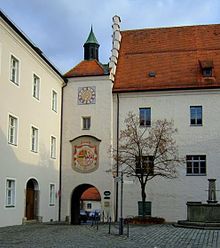Rent office Straubing

The Straubing Rent Office existed from 1507 to 1800 and, along with Munich , Landshut and Burghausen, was one of the four administrative districts of the Duchy of Bavaria . The Landshut and Straubing rentier offices formed the "Unterland". The Rentamt Amberg was by winning the Upper Palatinate in 1628, the fifth administrative district of the Electorate of Bavaria . Between 1802 and 1919 the rent office was a pure financial authority and thus a forerunner of today's tax office .
history
Viztume (from the Latin vicedominus), who exercised the rights of the duke in parts of the country where the duke was not permanently present, had held office in the Duchy of Bavaria since the 13th century. As the tasks of these vice masters increased over time, these rent masters were assigned as supporting officials. Since this u. a. controlled the finances of the ducal regional courts and other sub-authorities and with these tasks became increasingly more important than the vice-offices themselves, the vice-offices were called rent offices or rent master offices around 1500.
Landshut's vicarage was already proclaimed in 1300. It is unclear whether there has been a continuous succession of victumen since this year or whether in Straubing, where a duke resided for a long time in the course of the divisions of Bavaria (Duchy of Straubing-Holland ), the appointment of victumen was waived.
After the reunification of Bavaria as a result of the Landshut War of Succession , the duchy was reorganized around 1507 through an administrative reform. In Straubing - as in Burghausen and Landshut - a government was set up. This collegial authority had extensive administrative, legal and financial powers in the district entrusted to it. It fulfilled its most important task when it met as a court court. This formed the second instance for proceedings before the subordinate regional and nursing courts and the first instance for persons with a privileged place of jurisdiction (i.e. in particular the nobility and clergy). The members of the government (the government councils or regimental councils) were divided between the knight's bank (for aristocrats) and the scholar's bank (for lawyers). At the head of the government stood as a representative of the duke the victum, who belonged to the knight's bank. The chancellor, who was responsible for the administration of scriptures, headed the scholar bank. The most important official of the government, however, was the rentmaster. This supervised the authorities subordinate to the government. The most important instrument for this was regular inspection trips, the so-called rentmeister rides. In addition, he exercised the vicarage, by which body punishment could be converted into fines. In addition, the government also owned the rent clerk (deputy of the rent master), the district judge and the toll man.
The government had its seat in the ducal castle of Straubing , with the government college and the rent office in separate sections.
Until 1766, the Straubing Rent Office was geographically divided into upper courts (Abbach, Dietfurt, Haidau, Kelheim and Stadtamhof), medium-sized courts (Cham, Eschlkam, Furth, Kötzting, Mitterfels, Neukirchen and Viechtach) and lower courts (Bärnstein, Deggendorf, Diessenstein, Hengersberg, Leonsberg, Linden, Regen, Schwarzach, Weißenstein, Winzer and Zwiesel) In 1779 the Elector of Bavaria Karl Theodor dissolved the Landshut Rent Office and consequently closed some of the Straubing regional courts: Abensberg, Altmannstein, Vilsbiburg, Dingolfing, Eggmühl, Geisenhausen, Kirchberg, Landau, Landshut, Natternberg, Neustadt, Osterhofen, Riedenburg, Reisach, Rottenburg and Teisbach. Since this regional reform had not achieved the desired results and had also provoked conflicts with the Lower Bavarian nobility, the Landshut Rent Office was restored in 1784. The Straubing Rent Office now included the nursing courts Abbach, Abensberg, Altmannstein, Bärnstein, Cham, Deggendorf, Natternberg, Diessenstein, Dietfurt, Riedenburg, Furth, Haidau, Pfatter, Hengersberg, Weyr, Kelheim, Kötzting, Leonsberg, Mitterfels, Neustadt, Regen, Schwarzach , Straubing, Viechtach, Linden, Weißenstein and Zwiesel.
In the course of his administrative reforms, Minister Montgelas initially dissolved the rent office in 1800 and converted the Straubing government into the Straubing Court Court in 1802, from which the Straubing Court of Appeal emerged in 1809. In administrative matters, the regional courts of the former Rent Office were subordinate to the General State Directorate in Munich. When Bavaria was divided into districts (the forerunners of today's administrative districts) in 1808, the city of Straubing was initially assigned to the Regenkreis and from 1810 to the Lower Danube District, from which the district or administrative district of Lower Bavaria emerged in 1838 .
In addition, there was also a Straubing Rent Office. However, this was a pure sub-authority of the financial administration, which was only responsible for the city of Straubing and the surrounding area. It basically only has the name in common with the old rent office. In 1919 it was renamed the Straubing tax office.
Viztume and Rentmeister
|
Viztume
|
Rentmaster
|
literature
- Gerhard Schwertl: History of the Governments and Rentmeisterämter Landshut and Straubing 1507–1802 In: Negotiations of the Historical Association for Lower Bavaria, 116th - 117th volume, Landshut 1990–1991.
- Georg Ferchl: Bavarian Authorities and Officials 1550–1804 in: Upper Bavarian Archives Volume 53 (1908–12)
- Rentamt, the In: Adelung , grammatical-critical dictionary of the high German dialect , volume 3. Leipzig 1798, p. 1087 .
- Rent Office . In: Heinrich August Pierer , Julius Löbe (Hrsg.): Universal Lexicon of the Present and the Past . 4th edition. tape 14 . Altenburg 1862, p. 46 ( zeno.org ).
Individual evidence
- ^ Government Gazette 1802, Col. 793 - 797
- ↑ Son of his predecessor
- ↑ Frauenberg was named regional president from 1800 . From 1802 he was President of the Court.
- ↑ Sedlmayr was called von Edlmar after being ennobled in 1684
- ^ Son of Friedrich Sedlmayr.
- ^ Son of the vicarage Franz Ludwig Anton von Lerchenfeld.
- ^ Son of Johann Konrad von Berger.
